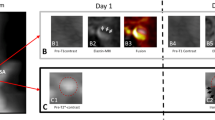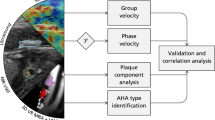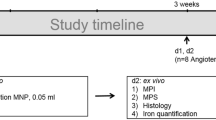Abstract
Atherosclerosis and its consequences remain the main cause of mortality in industrialized and developing nations. Plaque burden and progression have been shown to be independent predictors for future cardiac events by intravascular ultrasound. Routine prospective imaging is hampered by the invasive nature of intravascular ultrasound. A noninvasive technique would therefore be more suitable for screening of atherosclerosis in large populations. Here we introduce an elastin-specific magnetic resonance contrast agent (ESMA) for noninvasive quantification of plaque burden in a mouse model of atherosclerosis. The strong signal provided by ESMA allows for imaging with high spatial resolution, resulting in accurate assessment of plaque burden. Additionally, plaque characterization by quantifying intraplaque elastin content using signal intensity measurements is possible. Changes in elastin content and the high abundance of elastin during plaque development, in combination with the imaging properties of ESMA, provide potential for noninvasive assessment of plaque burden by molecular magnetic resonance imaging (MRI).
This is a preview of subscription content, access via your institution
Access options
Subscribe to this journal
Receive 12 print issues and online access
$209.00 per year
only $17.42 per issue
Buy this article
- Purchase on Springer Link
- Instant access to full article PDF
Prices may be subject to local taxes which are calculated during checkout





Similar content being viewed by others
References
Brown, B.G. et al. Simvastatin and niacin, antioxidant vitamins, or the combination for the prevention of coronary disease. N. Engl. J. Med. 345, 1583–1592 (2001).
Mock, M.B. et al. Survival of medically treated patients in the coronary artery surgery study (CASS) registry. Circulation 66, 562–568 (1982).
Ringqvist, I. et al. Prognostic value of angiographic indices of coronary artery disease from the Coronary Artery Surgery Study (CASS). J. Clin. Invest. 71, 1854–1866 (1983).
Schoenhagen, P. et al. Extent and direction of arterial remodeling in stable versus unstable coronary syndromes: an intravascular ultrasound study. Circulation 101, 598–603 (2000).
Jang, I.K. et al. Visualization of coronary atherosclerotic plaques in patients using optical coherence tomography: comparison with intravascular ultrasound. J. Am. Coll. Cardiol. 39, 604–609 (2002).
Kawasaki, M. et al. Volumetric quantitative analysis of tissue characteristics of coronary plaques after statin therapy using three-dimensional integrated backscatter intravascular ultrasound. J. Am. Coll. Cardiol. 45, 1946–1953 (2005).
Finn, A.V., Chandrashekhar, Y. & Narula, J. Seeking alternatives to Hard End Points: is imaging the best APPROACH? Circulation 121, 1165–1168 (2010).
Brasselet, C. et al. Collagen and elastin cross-linking: a mechanism of constrictive remodeling after arterial injury. Am. J. Physiol. Heart Circ. Physiol. 289, H2228–H2233 (2005).
Katsuda, S. & Kaji, T. Atherosclerosis and extracellular matrix. J. Atheroscler. Thromb. 10, 267–274 (2003).
Isik, F.F., Clowes, A.W. & Gordon, D. Elastin expression in a model of acute arterial graft rejection. Transplantation 58, 1246–1251 (1994).
Nikkari, S.T., Jarvelainen, H.T., Wight, T.N., Ferguson, M. & Clowes, A.W. Smooth muscle cell expression of extracellular matrix genes after arterial injury. Am. J. Pathol. 144, 1348–1356 (1994).
Masuda, H. et al. Adaptive remodeling of internal elastic lamina and endothelial lining during flow-induced arterial enlargement. Arterioscler. Thromb. Vasc. Biol. 19, 2298–2307 (1999).
Nili, N., Zhang, M., Strauss, B.H. & Bendeck, M.P. Biochemical analysis of collagen and elastin synthesis in the balloon injured rat carotid artery. Cardiovasc. Pathol. 11, 272–276 (2002).
Krettek, A., Sukhova, G.K. & Libby, P. Elastogenesis in human arterial disease: a role for macrophages in disordered elastin synthesis. Arterioscler. Thromb. Vasc. Biol. 23, 582–587 (2003).
Senior, R.M., Griffin, G.L. & Mecham, R.P. Chemotactic activity of elastin-derived peptides. J. Clin. Invest. 66, 859–862 (1980).
Karnik, S.K. A critical role for elastin signaling in vascular morphogenesis and disease. Development 130, 411–423 (2003).
Brooke, B.S., Bayes-Genis, A. & Li, D.Y. New insights into elastin and vascular disease. Trends Cardiovasc. Med. 13, 176–181 (2003).
Onthank, D. et al. Abstract 1914: BMS753951: A novel low molecular weight magnetic resonance contrast agent selective for arterial wall imaging. Circulation 116, II 411–II 412 (2007).
Nakashima, Y., Plump, A.S., Raines, E.W., Breslow, J.L. & Ross, R. ApoE-deficient mice develop lesions of all phases of atherosclerosis throughout the arterial tree. Arterioscler. Thromb. 14, 133–140 (1994).
Rosenfeld, M.E. et al. Advanced atherosclerotic lesions in the innominate artery of the ApoE knockout mouse. Arterioscler. Thromb. Vasc. Biol. 20, 2587–2592 (2000).
Mintz, G.S. et al. American College of Cardiology Clinical Expert Consensus Document on Standards for Acquisition, Measurement and Reporting of Intravascular Ultrasound Studies (IVUS). A report of the American College of Cardiology Task Force on Clinical Expert Consensus Documents. J. Am. Coll. Cardiol. 37, 1478–1492 (2001).
Botnar, R.M. et al. In vivo magnetic resonance imaging of coronary thrombosis using a fibrin-binding molecular magnetic resonance contrast agent. Circulation 110, 1463–1466 (2004).
Yeon, S.B. et al. Delayed-enhancement cardiovascular magnetic resonance coronary artery wall imaging: comparison with multislice computed tomography and quantitative coronary angiography. J. Am. Coll. Cardiol. 50, 441–447 (2007).
Kim, W.Y. et al. Three-dimensional black-blood cardiac magnetic resonance coronary vessel wall imaging detects positive arterial remodeling in patients with nonsignificant coronary artery disease. Circulation 106, 296–299 (2002).
Botnar, R.M. et al. Noninvasive coronary vessel wall and plaque imaging with magnetic resonance imaging. Circulation 102, 2582–2587 (2000).
Fayad, Z.A. et al. Noninvasive in vivo human coronary artery lumen and wall imaging using black-blood magnetic resonance imaging. Circulation 102, 506–510 (2000).
Wasserman, B.A. et al. Carotid artery atherosclerosis: in vivo morphologic characterization with gadolinium-enhanced double-oblique MR imaging initial results. Radiology 223, 566–573 (2002).
Botnar, R.M. et al. 3D coronary vessel wall imaging utilizing a local inversion technique with spiral image acquisition. Magn. Reson. Med. 46, 848–854 (2001).
Ibrahim, T. et al. Serial contrast-enhanced cardiac magnetic resonance imaging demonstrates regression of hyperenhancement within the coronary artery wall in patients after acute myocardial infarction. JACC Cardiovasc. Imaging 2, 580–588 (2009).
Helm, P.A. et al. Postinfarction myocardial scarring in mice: molecular MR imaging with use of a collagen-targeting contrast agent. Radiology 247, 788–796 (2008).
Nicholls, S.J. et al. Intravascular ultrasound–derived measures of coronary atherosclerotic plaque burden and clinical outcome. J. Am. Coll. Cardiol. 55, 2399–2407 (2010).
Lorenz, M.W., Markus, H.S., Bots, M.L., Rosvall, M. & Sitzer, M. Prediction of clinical cardiovascular events with carotid intima-media thickness: a systematic review and meta-analysis. Circulation 115, 459–467 (2007).
Mock, M.B. et al. Survival of medically treated patients in the coronary artery surgery study (CASS) registry. Circulation 66, 562–568 (1982).
Hadamitzky, M. et al. Prognostic value of coronary computed tomographic angiography in diabetic patients without known coronary artery disease. Diabetes Care 33, 1358–1363 (2010).
Libby, P. & Aikawa, M. Stabilization of atherosclerotic plaques: new mechanisms and clinical targets. Nat. Med. 8, 1257–1262 (2002).
Kaufman, L., Kramer, D.M., Crooks, L.E. & Ortendahl, D.A. Measuring signal-to-noise ratios in MR imaging. Radiology 173, 265–267 (1989).
Firbank, M.J., Harrison, R.M., Williams, E.D. & Coulthard, A. Quality assurance for MRI: practical experience. Br. J. Radiol. 73, 376–383 (2000).
Acknowledgements
This study was funded by a BHF project grant (PG/09/061) awarded to R.M.B. M.R.M. was partly funded by a BHF studentship awarded to R.M.B. ESMA (BMS753951) was provided by Lantheus Medical Imaging. Supporting data for the in vitro rabbit competition and in vivo mouse distribution studies were provided by P. Yalamanchili, M. Kavosi and P. Silva from Lantheus Medical Imaging.
Author information
Authors and Affiliations
Contributions
M.R.M. and R.M.B. are responsible for the overall study design and implemented and optimized the magnetic resonance imaging protocols. D.C.O., R.R.C. and S.P.R. designed and manufactured the contrast agent. U.B. and T.S. developed and implemented the T1 mapping sequence and analysis tools. M.R.M., R.M.B., A.J.W., A.S. and F.C. designed, conducted and analyzed the in vitro and in vivo experiments. A.W. performed the electron microscopy experiments. M.R.M., R.M.B., A.J.W., F.C., M.S.M., E.N., T.S., A.S., R.R. and C.H.P.J. contributed to the writing of the manuscript. All authors discussed and refined the manuscript.
Corresponding author
Ethics declarations
Competing interests
The magnetic resonance imaging scanner is partly supported by Philips Healthcare. A.J.W.is an employee of Philips Healthcare. D.C.O., R.R.C. and S.P.R. are employees of Lantheus Medical Imaging. The study was funded by the British Heart Foundation (PG/09/061), and the contrast agent was provided by Lantheus Medical Imaging.
Supplementary information
Supplementary Text and Figures
Supplementary Figures 1–3 and Supplementary Methods (PDF 2378 kb)
Supplementary Video 1
3D reconstruction (volume rendering) of elastin signal in the brachiocephalic artery of an Apoe−/− mouse. (MOV 257 kb)
Rights and permissions
About this article
Cite this article
Makowski, M., Wiethoff, A., Blume, U. et al. Assessment of atherosclerotic plaque burden with an elastin-specific magnetic resonance contrast agent. Nat Med 17, 383–388 (2011). https://doi.org/10.1038/nm.2310
Received:
Accepted:
Published:
Issue Date:
DOI: https://doi.org/10.1038/nm.2310
This article is cited by
-
A radioiodinated FR-β-targeted tracer with improved pharmacokinetics through modification with an albumin binder for imaging of macrophages in AS and NAFL
European Journal of Nuclear Medicine and Molecular Imaging (2022)
-
Elastin-specific MRI of extracellular matrix-remodelling following hepatic radiofrequency-ablation in a VX2 liver tumor model
Scientific Reports (2021)
-
Visualization of elastin using cardiac magnetic resonance imaging after myocardial infarction as inflammatory response
Scientific Reports (2021)
-
Non-invasive molecular imaging of kidney diseases
Nature Reviews Nephrology (2021)
-
Microdistribution of Magnetic Resonance Imaging Contrast Agents in Atherosclerotic Plaques Determined by LA-ICP-MS and SR-μXRF Imaging
Molecular Imaging and Biology (2021)



